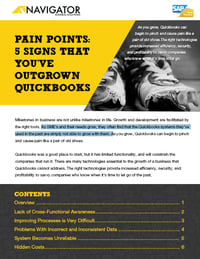
Top 5 Mistakes when Moving from QuickBooks to ERP and How to Avoid Them
Congratulations. You’ve either decided to move from QuickBooks to an enterprise resource planning solution (ERP), or you’re considering it.
This is a smart move; while QuickBooks is a leading platform for small business accounting, it also limits your growth because it lacks many of the features you need for long-term growth, such as deep automation, data validation, comprehensive real-time reporting and the completeness to oversee your entire business and not just financials.
While making the jump from QuickBooks to an ERP system is the right move for the growing business that is ready to take its operations to the next level, the transition does require some finesse; there are several “gotchas” that can slow down and cause headaches down the line.
So here are five of the most common mistakes that businesses make when they move from QuickBooks to ERP, and what you can do to avoid them.
Mistake #1: Sloppy Data Migration
The move from QuickBooks to an ERP solution naturally entails the porting of existing financial data into the new ERP system.
The migration of master data, opening balances and transactional data shouldn’t be taken lightly or given over completely to automated migration wizards, because it is easy to map data incorrectly or improperly move the data to the new ERP system.
Avoiding data migration headaches start with proper data migration planning, and then it requires a healthy dose import validation and double checking the results.
Mistake #2: Failure to Clean Data During Import
Most financial systems contain errors, and a Coopers and Lybrand study once found that 90 percent of all spreadsheets with 150 rows or more had errors.
A second mistake that many businesses make when they move from QuickBooks to ERP is failing to clean and validate data prior to their migration.
Bad data can delay migration, create cost overruns and expand the scope of a financial system migration project. The good news is that most ERP solutions offer import templates and data cleansing tools for cleaning data at the start. Use these tools.
Mistake #3: Inadequate Evaluation and Testing
One of the biggest mistakes that businesses routinely make when moving from QuickBooks to ERP is losing important requirements during the transition to the new system. Functionality and processes that were defined during the planning stage get “lost” during implementation, reducing the utility of the final product.
Businesses also routinely encounter trouble by assuming that ERP systems operate exactly the same way as QuickBooks. They then fail to test their assumptions about how the new ERP system will operate, encountering errors and inaccuracies later when fixing the issues is much harder.
Both of these challenges can be avoided with spending more time during the requirements phase to define exactly how the old system worked in QuickBooks, and what processes and configuration are needed from the new ERP solution. These requirements then should be rigorously tested during the migration to the new ERP system, ensuring that processes work as expected.
Mistake #4: Ignoring ERP’s Added Functionality
ERP systems can do a lot more than QuickBooks, and that probably is part of why your business is moving from QuickBooks to ERP. What some businesses don’t consider, however, is how this added functionality can cause trouble later if not considered at the onset.
One good example is the migration of the General Ledger from QuickBooks to the small business accounting module in SAP Business One. QuickBooks doesn’t support flexible account segmentation, while SAP Business One allows up to 10 account segments. If a business moves from QuickBooks to SAP without considering the extended structural capabilities of the new system, it likely will cause trouble down the line when the business has to change its entire general ledger structure. Much better and easier to make the adjustment during the initial migration.
This mistake can be avoided by understanding the complexity and new opportunities from an ERP system and making necessary adjustments during migration, not afterwards. Don’t just port what you were doing before to the new ERP system.
Mistake #5: Not Getting Expert Advice
ERP has gotten a lot easier thanks to the cloud, but the migration from QuickBooks to ERP still isn’t drag-and-drop easy. ERP systems are complex, and migration from QuickBooks to one of these more complete solutions requires both careful planning and an understanding of how ERP systems work.
Businesses should not make the migration alone, especially considering that the task involves a company’s financial data.
So the final big mistake that companies make when moving to ERP is trying to handle the entire migration process on their own. If ever there was a time for a consultant who understands and has experience with the process being undertaken, this is it. Work with your ERP vendor or hire a certified ERP consultant when planning your migration from QuickBooks to ERP.
Moving your financials to an ERP solution is usually a smart move, but there are plenty of gotchas that can cause trouble along the way. So go in with a solid plan and your eyes wide open.
